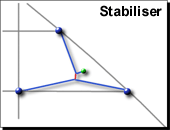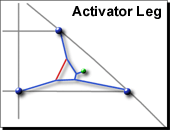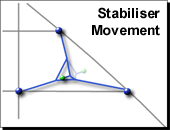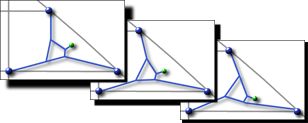|
|

楼主 |
发表于 2009-7-21 22:04:35
|
显示全部楼层
Static Bridle 即静态提线,是一种很标准的提线,现在占主流的turbo就是由静态提线发展过来的
下面是Active Bridle 直面翻译是 活跃提线,文章是它与静态提线的比较和优势所在
The Active BridleTop Close Open
The fundamental principle of any dynamic bridle is to have a tow point that can automatically move its position relative to the kite. The Active Bridle does this with the addition of two extra legs that give the bridle the required latitude of movement in the correct orientation to optimise the benefits of variable bridle positions for different conditions, positions, maneuvers and tricks.
As is typical of all dynamic bridle configurations, the Active Bridle allows movement of the tow point while keeping all sections of the bridle taut. This is necessary to maintain the best level of control of the kite and to optimise the responsiveness of the kite to user input. For the tow point to move in a static bridle, one or more lines of the bridle must go slack. The design goal for the Active Bridle is to allow as much movement as is necessary to improve the flying characteristics of the kite while maintaining the shape and tautness of the bridle as much as possible.
 | Diagram 2
Stabiliser Leg |
The first additional leg, known as the "Stabliser", shown in red on Diagram 2, makes a connection between the upper leg and the lower legs.
 | Diagram 3
Activator Leg |
The second additional leg, known as the "Activator", shown in red on Diagram 3, connects the inner and upper legs together, pulling them in slightly.
 | Diagram 4
Stabiliser Movement |
Diagram 4 shows the effect of the Stabiliser leg in allowing the tow point to move out towards the leading edge and in towards the spine. The effect of this is such:
- When the kite is being flown in a straight line, pressure is roughly equal on each flying line (i.e. the flyer's hands are at the same distance). In this state, the Active Bridle shifts to move the tow points further in towards the spine. This increases the precision in straight line tracking.
- When the flier pulls (or pushes) on one line to execute a turn, the tow point on the line being pulled moves out towards the leading edge. This improves the kite's turning ability.
- The turning rate of the kite can be more closely controlled. A slight difference of pressure on the lines will create a slow, arcing curve, while at the other extreme, a hard pull on one line will create a very fast and tight spin.
Diagram 5 shows the effect of the Activator in controlling the pitch of the kite, effectively moving the tow point relatively up or down.
- When the pressure on the sail is light, the tow point shifts up, effectively pulling the nose of the kite in towards the flier. This improves the kite's responsiveness in light wind and also at the outer and upper edges of the wind window.
- When the pressure on the sail increases, the tow point shifts down and the nose of the kite is pushed away from the flier slightly. This slows the kite down in high wind and helps to control speed in the centre of the wind window. It also serves to buffer gusts, making for a smoother flying kite.
- The effects of pitch control as described above give the kite a larger wind window and provide a more consistent speed across different parts of the window and in different wind conditions.
 | Diagram 5
Activator Movement |
|
|
 |Archiver|手机版|小黑屋|特技风筝网
( 京ICP备13037480号 )
|Archiver|手机版|小黑屋|特技风筝网
( 京ICP备13037480号 )  |意见建议
|意见建议